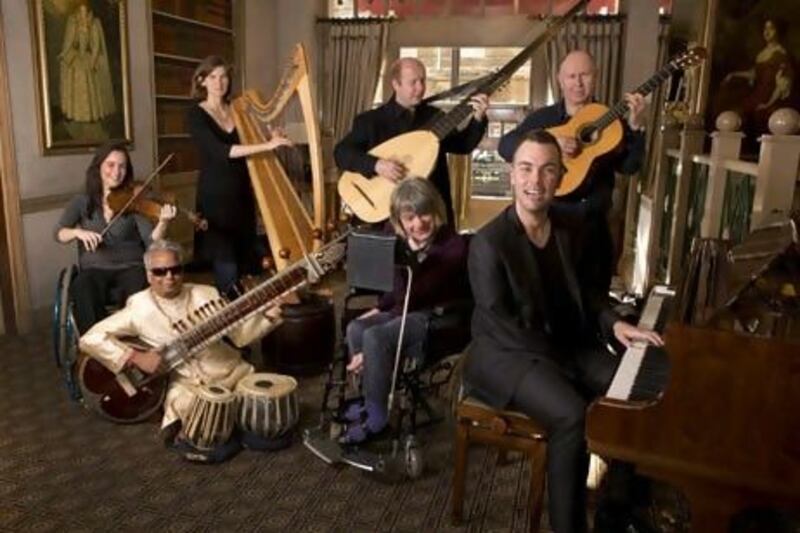It's not like any orchestra you've ever seen or heard. There are no ranks of brass or decks of strings, rows of penguin-suited men and evening-gowned women. The conductor does not stand on a podium and direct a piece by Beethoven or Brahms. It is an altogether smaller ensemble, but with a giant ambition.
This is the British Paraorchestra, a collection of virtuosic musicians from wildly diverse backgrounds with one thing in common: they are all, in some way, disabled.
Take Nicholas McCarthy. He is an award-winning pianist who was born with no right arm. He began playing the piano at 14 and has just finished his studies at the Royal College of Music - the only left-handed pianist to do so. Also a member is Clarence Adoo, who was one of the jazz world's top trumpeters, playing with the likes of Courtney Pine, until a road accident left him paralysed from the neck down. Now he plays the Head=Space Instrument, a highly calibrated computer controlled by his breath and the tiny movements of his head.
Lyn Levett is an electronic music producer who uses Mac-based software in a way that is, according to the conductor Charles Hazlewood, "dizzyingly creative". She has cerebral palsy. Other musicians include several blind virtuosi such as the Japanese violinist Takashi Kikuchi, the Lebanese multi-instrumentalist Ziad Sinno, the violin and keyboards player Abi Baker, the lutenist Matthew Wadsworth, the baroque recorder player James Risdon and the Indian multi-instrumentalist Baluji Shrivastav - who has performed with everyone from Stevie Wonder to Massive Attack. It's a growing orchestra, with a broad remit, but, says Hazlewood, what they all have is "virtuosity, passion and a kind of fearlessness".
That fearlessness in improvisation is, believes Hazlewood, what makes this music different to anything that has been played before. The standard repertoires are abandoned in favour of a system of improvisation so the orchestral members feel a sense of "collective ownership" of the material they play.
"It sounds a bit like cod psychology, but I think that if you, either by dint of birth or accident, have had very unusual challenges to circumnavigate in your personal life, you are not going to be worried about what people think of you, how you look, how you sound," he explains. "All those basic issues of neurosis and ego just don't exist in this community of musicians. There's an intense bravery about the way they make music, which means that there's a kind of new horizon that I've encountered."
Hazlewood, a conductor whose experience, tastes and projects are as eclectic as the orchestra's personnel, was inspired by his young daughter, who has cerebral palsy, to create the Paraorchestra. Coming into contact with the disabled community, it occurred to him that, in 20 years of conducting around the world, he could count on one hand the number of disabled musicians he had encountered in orchestras. He announced the launch of the British Paraorchestra at the TED Global Summer Conference last July in Edinburgh. One year later, at the Orchestra In A Field festival, the orchestra made its debut performance.
"People scratched their heads and went, well yes, it's a no-brainer. The Paralympics has taken over 50 years to arrive at the point today. And there can't be an intelligent person on the planet any more who doesn't believe in its value. So as soon as I said I want to do the same thing but for music, to create a brightly lit platform for the most brilliantly gifted musicians who happen to be disabled, people were like, 'Well of course, I can't believe that hasn't happened before.'"
When he puts it like that, it really is a wake-up call. After all, the history of music is studded with disabled musicians: Beethoven, whose loss of hearing may have been the catalyst for the extraordinary changes he wrought in composition; Paul Wittgenstein, a pianist who lost his right arm during the First World War and subsequently commissioned works for left-handed piano from composers including Ravel, Britten, Hindemith, Prokofiev and Richard Strauss; Dame Evelyn Glennie, the virtuosic solo percussionist who has been profoundly deaf from the age of 12; Rick Allen, the drummer for Def Leppard who lost an arm in a street-racing accident; soul pioneers Ray Charles and Stevie Wonder, both blind.
One of the British Paraorchestra's musicians, Gemma Lunt, who plays viola and saxophone, admits she had never noticed the lack of disabled musicians in orchestras until she found herself trying to join ensembles at her music college after returning to her studies following a life-changing accident.
Lunt, 29, has been involved in music since the age of five, and was partway through her viola studies at Trinity Laban Conservatoire in London when she suffered an anaphylactic reaction while at the top of the stairs on a double-decker bus - "it was wrong place, wrong time," she says. Since her fall she has been in a wheelchair, suffering from nerve damage and in constant pain. She was told she would never play again, but persevered and managed to resume her course at Trinity.
"Going back, people were not wanting to play with me," she says. "I just found that very odd. A few years on, just as I was leaving, they started to, but I think it was people's perceptions, and I found that very difficult. There's no reason that I'm aware of. I only started to notice when I was in the wheelchair. I just became aware, like Charles did, that there were very few [disabled] musicians, and I don't understand why it is."
In a rehearsal space just off London's unglamorous Caledonian Road, the British Paraorchestra is coming to the end of an improvisation on the theme of the English folk melody Greensleeves. Hazlewood sits, so low he's almost crouching, at the foot of the semicircle of musicians, who look to and listen to each other as much as to him for musical cues.
Among the rehearsal attendees is Rolf Gehlhaar, the composer, musician and electronics visionary who created Clarence Adoo's musical instrument. Gehlhaar, who studied with Stockhausen, is a pioneer in electronic interactive music, particularly with disabled children, and uses modern technology to create instruments with the potential to open up a world of creativity to even the most severely disabled. For example, he has used the Kinect sensor - the motion sensor in the Xbox 360 - to design the eyeSound, an instrument that projects a mesh of infrared dots to create a sonic force field that can be played with tiny movements - a sort of high-tech Theremin.
"Technology and music complement each other," he says. "I wouldn't want to do one without the other. For hundreds of years the organ was the most complicated piece of machinery invented by humans."
For Gehlhaar and the musicians he works with, there's no question of allowing the computer to do everything. "There are lots of sound toys, and they have their place," he says, "but my interest is in musical instruments, which means that they're sophisticated, completely intentional, immediate and difficult to learn. And it's always going to require practice."
Gehlhaar is, however, cautious on the subject of whether technology can allow a blossoming of musical ability among the disabled, for the very practical reason that it is expensive.
"There have been for quite a long time ways of developing assistive technology, but people just didn't. I discovered it by accident, against considerable resistance, and many people didn't do it because there's just no money in it. It's expensive to do and generally disabled people are poor, so you not only have to find a way to assist them through technology but you also have to find a way to assist them financially. Instruments are hardly available to normal schoolchildren, so how can they be available to disabled kids?"
Hazlewood is more optimistic. "We now have this incredible array of digital technology which means that anyone with any kind of physical impairment can absolutely and genuinely make music to the highest level," he says. "People just don't know that the technology is out there. It's much less visible than the technology associated with sport because there hasn't been the take-up for it because there hasn't been the attention or focus on it."
That looks likely to change very soon, with the British Paraorchestra undertaking a series of high-profile concerts at Aldeburgh, the Southbank and, last month, at the reception dinner for Team GB's paralympic athletes. The orchestra is also expected to be on the line-up for the Paralympic Closing Ceremony on September 9, and a documentary has been made about it for Channel 4.
But for all the affirmation and celebration involved, it's a concept that will ultimately come down to the quality of the music and the brilliance of its players. "It's not a project about warm feelings that they took part," says Hazlewood. "It's really about making the very highest levels of music to change people's perspectives. In a handful of years I would hope there will be many more fully evolved musicians with disability playing in every orchestra, ensemble and band around the world. That's the ambition. That's why I called it the British Paraorchestra; because I sort of wanted to throw down the gauntlet to the world, to say, here's the British one: where's yours?"
Gemma Champ is a regular contributor to The Review.










